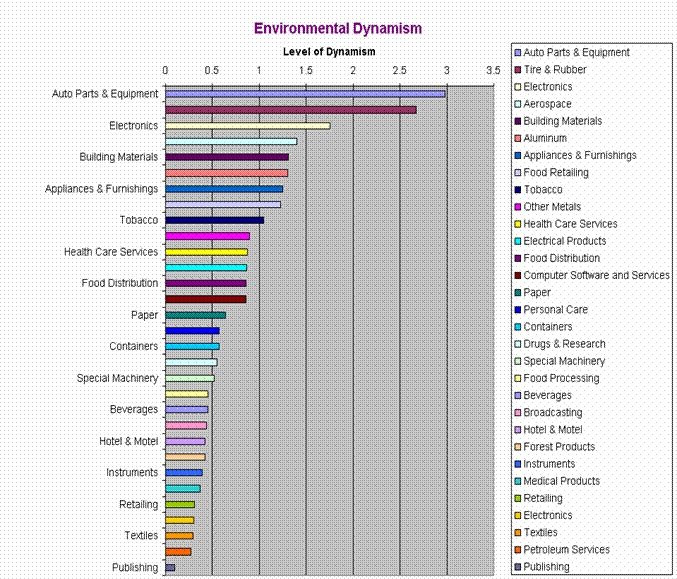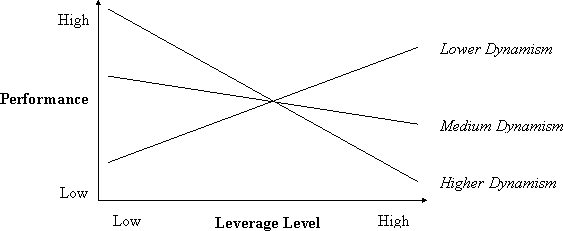Translating Research into Practical Solutions
by Roy L. Simerly and Mingfang Li
Roy L. Simerly SIMERLYR@MAIL.ECU.EDU is a Professor of Management at East Carolina University. Mingfang Li is a Professor of Management at California State University, Northridge.
Abstract Is your stock price raising concerns among investors? Are you worried about your companyís financial performance? Warning: Taking on more debt to solve management problems can be dangerous for the long-term health of your firm! Decisions concerning the capital structure must take into consideration the competitive environment of the firm. [1] B>Quest's Table of Contents |
Readers are invited to submit comments about this or any other article in B>Quest for possible publication in the "commentary" section of B>Quest. If you would prefer that this page be a different color or white background, click here.
We argue that the use of leverage either to discipline managers or to achieve economic gain is the Ďeasy way outí, and, in many instances, can lead to the demise of the organization.† The fact that an optimal capital structure has not been found is an indication of some flaw in the logic. We believe that the original question was framed incorrectly. Rather than: What is an optimal mix of debt and equity that will maximize shareholder wealth; it should have been: Under what circumstances should leverage be used to maximize shareholder wealth? Why? Because debt and equity have profound long-term implications for corporate governance that far exceed the exigencies of the moment.
A better understanding of the issues at hand requires a look at the genesis of the concept of using debt to control managers and to reconcile this thinking with the need to survive in the competitive environments of today.
††††††††††† One of the defining characteristics of business in the 1990s was the adoption of prescriptions from agency theory to address the managerial excesses of the 1970ís and 1980ís. The classic agency theory concept was developed by Berle and Means (1932) [4].† They observed that ownership and control had become separated in larger corporations as a result of the dilution in equity positions.† This situation provided an opportunity for professional managers, as those in control, to act in their own best interest.† Today, the central issue for agency theory is how to resolve the conflict between owners and managers over the control of corporate resources through the use of contracts which seek to allocate decision rights and incentives.
††††††††††† Managers have a number of incentives to pursue growth-oriented strategic options.† The larger the organization, the greater the economic and political power of the top management teams, and the greater the ability of the organization to marshal resources necessary to deal effectively with its competitive and social environment.† Also, larger organizations are seen as being able to maintain their freedom from the discipline of the capital markets.† As a generalization, it can be said that growth does lead to increasing the wealth of shareholders.† However, the concern is that too many of the activities associated with increasing the size of organizations are motivated not by a desire for maximizing shareholder wealth, but by opportunities for the self-aggrandizement of management.
††††††††††† The contractual device suggested by agency theory to accomplish the transfer of wealth from the organization to the investors is debt creation.† Debt provides a means of bonding managerís promises to pay out future cash flows.† It also provides the means for controlling opportunistic behavior by reducing the cash flow available for discretionary spending.† Top managersí attention is then clearly focused on those activities necessary to ensure that debt payments are made.† Companies failing to make interest and principal payments can be declared insolvent and can be dissolved.† This use of debt as a disciplinary tool makes survival in the short-term the central issue for all concerned.
Agency theory also has important implications for the relationship between stockholders and debt-holders.† Stockholders are interested in the return over and above that amount which is required to repay debt.† Debt-holders are only interested in the debt payment specified in the contract.† Stockholders are seen as sometimes being interested in pursuing riskier business activities than debt-holders would prefer.† When this occurs debt-holders may charge higher prices for debt capital and institute greater control measures to prevent top managers from investing capital in riskier undertakings.
However, agency theory does not take into consideration competitive environments, nor does it consider the necessity for managers to make choices beyond a stockholder wealth-maximizing perspective. This would seem to be a serious omission for two reasons.† First, debt and equity represent different constituencies with their own competing, and often mutually exclusive, goals.† Second, as the level of debt increases, the corporate governance structure can change from one of internal control to one of external control.† For firms that adopt debt as a control mechanism, lenders become the key constituents in the corporate governance structure. This can have a significant impact on both managerial discretion, and on the ability of an organization to deal effectively with its competitive environment.
A distinguishing characteristic of the strategic management discipline is the emphasis it places on the firmís competitive environment. An organization must find a match or fit between the demands of its competitive environment and its internal management systems in order to succeed and to survive.† The management system and organizational structure most appropriate for any given firm will be a product of the specific set of environmental contingencies being faced.
Strategic management also recognizes that the firm has multiple constituencies and objectives, and it accepts that it may not be possible to maximize the returns to all constituencies, or to achieve all objectives. More importantly, strategy is concerned with the long term survival of the organization within its competitive environment.† This requires a more complex model of the firm than that envisioned by either finance or economics.† These disciplines assume away cognitive limits in their assumption of complete information and efficient markets. Strategic management, on the other hand, accepts the argument that managers are limited in their ability to gather and process information.† Therefore, we can say that the choice of capital structure is less a matter of predefined alternatives and more a search for alternatives in a complex and uncertain environment.
Across industries there are significant differences in the environmental characteristics impacting firms.† Most relevant among these characteristics is environmental dynamism, defined as the rate of environmental change, and the instability of that change. Environmental dynamism is a product of several forces operating at one time.† These include an increase in the size and number of organizations within an industry, and an increase in the rate of technological change and its diffusion throughout that industry.
For all parties involved (including top managers, stockholders, debt-holders and others), as environmental dynamism increases it will result in actorsí increased inability to assess accurately both the present and future state of the environment.† This limits their ability to determine the potential impact of decision-making on current and future business activities, and to determine viable alternatives which organizations should pursue. This means that an effect of increasing levels of environmental dynamism is to reduce access to knowledge needed to make critical decisions. This, in turn, reduces the stability and predictability of relations among firms and their constituents within an industry.† It is then a logical inference that varying degrees of environmental dynamism can have a differential impact on similar activities occurring across industries.† That is, as the degree of environmental dynamism varies across industries, it is reasonable to expect that there should be significant differences in the adaptive capabilities required for survival, and that these differences should have performance implications.
We demonstrate this relationship in Table 1 [5] (below). This table is a rank ordering of industries based on the degree of measured environmental dynamism. Industries toward the top of the table are in industries characterized as having a high level of dynamism. That is, the rate of change and the degree of uncertainty concerning future states makes decision-making difficult. Conversely, firms in industries toward the bottom of the table are in relatively benign environments.
Table 1

From a firmís perspective, a higher cost of debt capital can decrease its attractiveness to various stakeholders, and greater external control by debt-holders may interfere with the firmís ability to navigate effectively within its competitive environment.† This would indicate that firms needing to engage in riskier business activities because the firm must respond to changing competitive pressures, the use of debt financing would be an impediment subjecting managers to both the discipline and constraints of the capital markets.
These data were used to examine the economic performance of over 700 firms across 31 industries. The results are shown in Figure 1 (below). We found that those firms in industries characterized as exhibiting high levels of dynamism were more successful if they had relatively low levels of debt. In other words, debt was negatively related to profit in these industries. We further examined the relationship between debt and innovation with similar findings. In more dynamic environments debt-holders are less likely to appreciate the need to invest in long-term projects with questionable pay-offs.
Figure 1
The relationship between economic performance and debt across types of environment

The results demonstrated in Figure 1 also allow us to provides guidance for practitioners and investors on how to approach the capital structure question. Those firms in industries toward the top of the table should choose equity over debt in financing projects with uncertain outcomes. Those firms in industries toward the bottom of the table should consider increasing debt to increase returns to investors. There are practical examples of this from the 1990s. Coke, located in an industry toward the bottom of the table, did increase its debt in 1998. This resulted in a significant increase in shareholder wealth and returned excess cash flow to investors. In contrast, Kodak, located in an industry toward the top of the table, has struggled through most of the 1990s with excess debt relative to other firms in its industry. As a result, investors have forced the firm to cut back on necessary research and development, and inhibited the firms expansion into emerging high tech industries.
The results of this study should be seen as a serious challenge to the traditional capital structure literature.† One of the dramatic changes created by the expanding global economy is the increase in the rate of change within industries. We suspect that as more industries are experiencing greater levels of change, we will find the use of debt-centered governance will prove less effective in the near future.
The first duty of managers is to ensure the long-term survival of the organization within its competitive environment. In a world devoted to quick fixes, and short-term thinking edited by sound bites, it is difficult to take time to think through serious challenges. As environments become more competitive, those who make the time to reach appropriate decisions will be the ones left standing.
Footnotes
1. This paper is based on our article, Environmental dynamism, capital structure and performance: A theoretical integration and empirical test, Strategic Management Journal, Vol. 21, 31-49, 2000.
2. Modigliani, F. and M. H. Miller, 1958. The cost of capital, corporate finance and the theory of investment, American Economic Review, Vol. 48, 261-297.
3. Champion, D. 1999. Finance: The joy of leverage. Harvard Business Review, July/August, 19-22.
4. Berle, A. A. and G. C. Means, 1932. The Modern Corporation and Private Property. Macmillan, New York.
5. The date in this table are representative. Dynamism varies across industries and across time. Specific calculations should be made for each industry when decisions are being considered.
If you do not like the background color, you can change it by highlighting a color you prefer in the scroll box below.
B>Quest
(Business Quest)
A journal of applied topics in business and economics